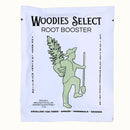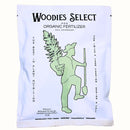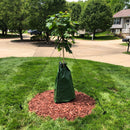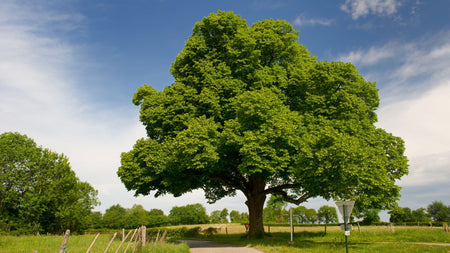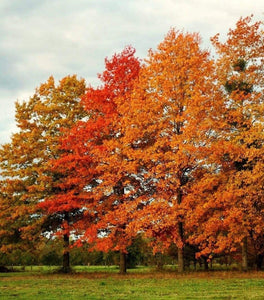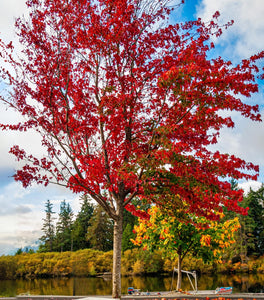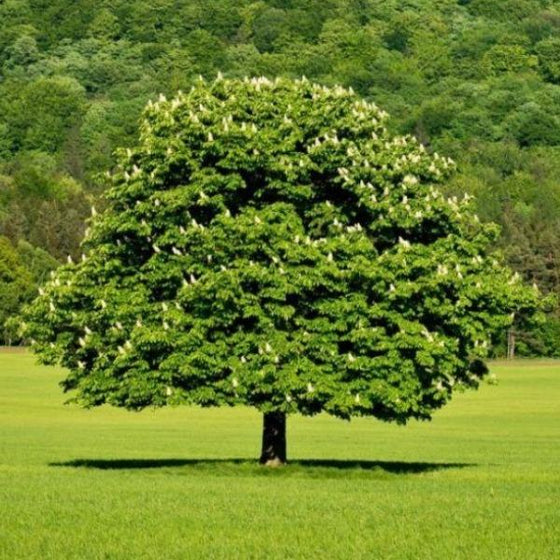
Images Depict Mature Plants
Dunstan Chestnut Trees for Sale Online
Dunstan Chestnut Trees (Castanea dentata x Castanea mollissima) are prized for their fast growth, prolific nut production, and exceptional resistance to chestnut blight. A hybrid of American and Chinese chestnuts, Dunstan Chestnuts combine the robust, upright form and cold hardiness of the American chestnut with the disease resistance of the Chinese variety—making them one of the best choices for reintroducing chestnuts into North American landscapes. These deciduous trees produce large, sweet, easy-to-peel nuts that are ideal for roasting, baking, or feeding wildlife.
Dunstan Chestnut Trees grow rapidly—up to 2 to 4 feet per year—and can reach 40 to 60 feet at maturity, creating an impressive canopy of glossy, serrated green leaves that turn golden in fall. They begin bearing nuts in just 3 to 5 years and require at least two trees for cross-pollination and optimal nut yield. Perfect for orchards, food plots, edible landscapes, and homesteads, these trees support native wildlife, including deer, turkey, and small mammals, while also offering a sustainable, low-maintenance food source.
Hardy in USDA Zones 5–9, Dunstan Chestnuts thrive in full sun and well-drained, slightly acidic soil. Their resistance to blight makes them an excellent alternative to the now-rare American chestnut, and they perform well in both rural and suburban settings. Whether you're looking to plant for nut production, wildlife support, or restoration purposes, Dunstan Chestnut Trees offer beauty, productivity, and ecological value with lasting impact.
Dunstan Chestnut Tree History
Once beautiful and abundant, the American Chestnut Tree (Castanea dentata) covered vast tracts of land across the eastern United States for thousands of years. That is until a fungus (blight) from Asia decimated virtually every tree standing on North American soil.
After nearly 70 years of absence, the American Chestnut is poised to make a comeback thanks to the Dunstan Chestnut.
Dr. Robert T. Dunstan cross-pollinated American grafts with USDA Chinese chestnut selections. The result is a blight-resistant Chestnut Tree.
This hardy tree is easy to grow and thrives in various areas. Chestnuts are the very best tree for wildlife. Their consistent yearly crop of large, sweet nuts (unlike oaks and other nuts that cycle between heavy and light-years) provides regular, high-quality food for deer, turkeys, squirrels, and bears. For a more in-depth history of the Chestnut Tree and a look into its future, be sure to check out our blog: What Happened To The Chestnut Tree?
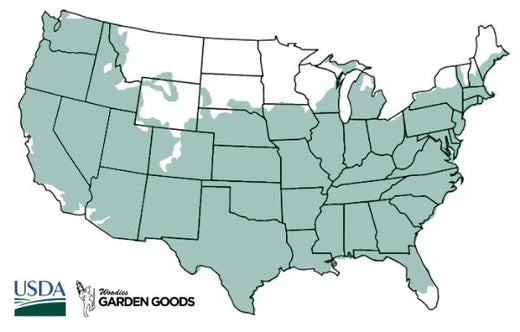
| Hardiness Zone: | 5-9 |
|---|---|
| Mature Height: | 40 to 60 feet |
| Mature Width: | 25 to 30 feet |
| Classification: | Broad leaved deciduous tree |
| Sunlight: | Full sun |
| Habit: | Upright, umbrella shaped canopy |
| Foliage: | Dark green |
| Flower Color: | Inconspicuous |
| Pruning Season: | No pruning needed |
| Soil Condition: | Any well-drained soil |
| Water Requirements: | Water well until established |
| Uses: | Tolerates moist soil and full sun. Full sun brings out the best fall color. Will adapt to drier sites. |
How to Care for Dunstan Chestnut Tree
Before you buy a Hybrid American Chestnut Trees, make sure to read about the care instructions that are required and recommended to keep this plant healthy and flourishing.
How do I plant my Dunstan Chestnut Tree?
Planting your Dunstan Chestnut Tree correctly is key to ensuring healthy growth, long-term productivity, and successful nut harvests. Start by selecting a location that receives full sun—at least 6 to 8 hours per day—and has well-drained, slightly acidic soil with a pH between 5.5 and 6.5. Avoid low-lying areas where water may collect, as chestnuts do not tolerate wet roots. Dig a hole twice as wide and just as deep as the tree's root ball. Place the tree in the hole so that the root collar (where the trunk flares at the base) is level with the soil surface, then backfill with the original soil, gently firming it around the roots. Water your Dunstan Chestnut Tree thoroughly after planting and apply a 2–3 inch layer of mulch around the base to retain moisture and suppress weeds—keeping the mulch a few inches away from the trunk to prevent rot. Space multiple trees at least 30–40 feet apart to allow for mature growth and proper air circulation, and plant at least two for cross-pollination and optimal nut production. With proper planting and early care, your Dunstan Chestnut will establish quickly, offering shade, fall foliage, and delicious, sweet chestnuts in just a few years.
How do I fertilize my Dunstan Chestnut Tree?
Fertilizing your Dunstan Chestnut Tree is essential for promoting vigorous growth, healthy foliage, and consistent nut production. During the first year, hold off on fertilizing to allow the roots to establish in their new environment. In the second year, begin applying a balanced slow-release fertilizer—such as 10-10-10—in early spring just as the tree breaks dormancy. Spread the fertilizer evenly around the drip line (the area beneath the outer edge of the tree’s canopy), keeping it several inches away from the trunk, and water thoroughly after application to help nutrients penetrate the soil. As your Dunstan Chestnut Tree matures, increase the amount of fertilizer each year in proportion to its size, and continue fertilizing each spring for best results. Avoid high-nitrogen fertilizers, which can encourage excessive leafy growth at the expense of nut development. For a more organic approach, apply composted manure or well-aged compost annually to enrich the soil and improve overall tree health. With consistent, nutrient-rich feeding, your Dunstan Chestnut Tree will reward you with strong growth, beautiful form, and abundant crops of large, sweet chestnuts that are perfect for both wildlife and home harvests.
How often do I water my Chestnut Tree?
Watering your Dunstan Chestnut Tree properly is crucial, especially during its first few years, to help it establish a deep and healthy root system. In the first growing season, water deeply once or twice a week, depending on rainfall, to ensure the soil stays consistently moist but never soggy. Focus on watering at the base of the tree, allowing the water to soak into the root zone. A slow, deep watering method—such as drip irrigation or a soaker hose—is ideal for preventing runoff and promoting deep root growth. Applying a 2–3 inch layer of mulch around the base (but not touching the trunk) will help retain moisture and regulate soil temperature. Once established, Dunstan Chestnut Trees become more drought-tolerant but still benefit from supplemental watering during dry spells, especially in the summer months or during nut development. Check the soil moisture regularly; if the top 2–3 inches are dry, it’s time to water. In sandy or fast-draining soils, trees may need more frequent irrigation. Proper watering encourages lush foliage, strong structural growth, and reliable annual nut production, making it one of the most important parts of maintaining a healthy, productive Dunstan Chestnut in your home orchard or wildlife plot.

How and when should I Prune my Dunstan Chestnut Tree?
Pruning your Dunstan Chestnut Tree is essential for shaping its structure, promoting airflow, and improving light penetration, all of which support healthy growth and abundant nut production. The best time to prune is in late winter or early spring while the tree is still dormant and before new buds begin to swell. Start by removing any dead, damaged, or diseased branches, followed by inward-growing or crossing limbs that could lead to crowding. For young trees, focus on developing a strong central leader and evenly spaced scaffold branches to form a balanced, open canopy that will support long-term growth. As your Dunstan Chestnut Tree matures, annual light pruning will help maintain its shape and productivity. Avoid heavy pruning during the growing season, as this can stress the tree and reduce nut yield. If needed, remove suckers or water sprouts during summer to redirect the tree’s energy toward fruiting. Always use clean, sharp tools to make clean cuts just outside the branch collar to encourage proper healing. With regular and well-timed pruning, your Dunstan Chestnut Tree will stay structurally sound, visually appealing, and productive—yielding sweet, high-quality chestnuts season after season.
Additional Information
The Dunstan Chestnut trees (Castanea dentata x mollissima) provide tasty chestnuts for roasting and eating whole or to be used in many cooking recipes. This blight-resistant tree is one of the most high-demand fruit/nut trees in the U.S. Although Dunstan Chestnut Trees will bear chestnuts 3 to 5 years after planting, it needs at least two trees to produce nuts.
As long as you have two or more American Hybrid Chestnut Trees planted within 30 to 40 feet of each other, you will enjoy a full chestnut crop year after year. We recommend spacing your trees out no less than 25 to 30 feet apart so they will have adequate space at maturity. Dunstan Chestnuts bloom in the spring and ripen by mid fall.










